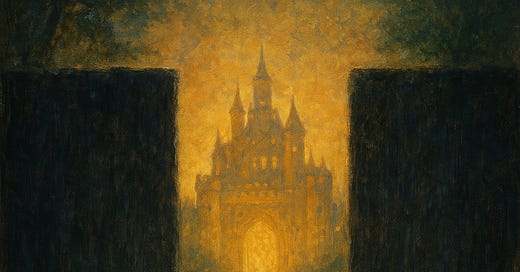A disciple once came to the Baal Shem Tov, the great Jewish mystic, overcome with despair.
"No matter how hard I try," he said, "I feel distant from God. My prayers feel hollow. The good deeds I do—they don't uplift me. I feel like I'm trapped outside a castle I'll never enter."
The Baal Shem Tov listened quietly, then invited him to close his eyes.
"Imagine," he said, "that you are walking through a vast forest. In the distance, you see a palace glowing with light. You begin walking toward it. But every few steps, a wall appears before you—thick and tall. You turn back, defeated."
The disciple nodded. That’s exactly how it feels.
The Baal Shem Tov leaned in and whispered:
"Each wall is an illusion. If you had kept walking, your body would have passed right through it. The walls are made of your fear, your self-judgment, your certainty that you are unworthy. You stop—not because you must, but because you believe you must."
The disciple opened his eyes, tears falling freely.
"God is not hiding from you," the Baal Shem Tov said gently. "You are hiding from God, behind walls your own thoughts have built."
Can You Relate?
We ache for connection—and yet we pull away.
We dream of bold action—but convince ourselves we’ll fail.
We long to create—but wait for someone to give us permission.
The paralysis is painful. But the path through it is rarely clear.
Kafka captured this ache in his parable Before the Law.
A man comes to a gate, seeking entry to the Law. The gatekeeper says: “Not yet.” So he waits. For years. For decades. He grows old beside the gate, peering in but never entering. Only at the end, as life fades, he asks, "Why has no one else come here?" And the gatekeeper replies: “This entrance was meant only for you. Now I shall close it.”
Like the disciple in the forest, the man never realized—
The barrier was never the gate. It was the belief that he couldn’t walk through it.
So What Can We Do?
1. See Through the Eyes of Faith
What we see depends on how we look.
One person sees the world as a puzzle to solve. Another sees a mystery to embrace.
One sees obstacles. Another sees invitations.
The difference isn’t in the facts—it’s in faith.
And faith isn’t certainty. It’s what Rabbi Jonathan Sacks called:
“The courage and the curiosity to live with uncertainty.”
2. Change the Language You Use
Words are spells. They shape thought.
Instead of saying “I’m starting,” say “I’m experimenting.”
Starting sounds heavy. It implies commitment, pressure, success or failure.
But experimenting? That’s light. Playful. Forgiving.
Experiments can fail—and still be worth doing.
And so can we.
3. Build Habits with a Bias for Action
One of Judaism’s boldest insights is this:
Deed before creed.
Do the thing—even if you’re not sure yet.
The action shapes the inner world.
Say the blessing, even if you don’t feel it.
Make the call, even if it feels awkward.
Light the candle, even if the room is still dark.
Let your body lead your spirit forward.
The Narrow Bridge
Rabbi Nachman of Breslov, the Baal Shem Tov’s great-grandson, once said:
“The whole world is a narrow bridge, and the most important part is not to be afraid.”
The metaphor is perfect. A bridge connects. And what matters most in life—what gives it strength and beauty—is connection.
Connection to others.
Connection to our deepest longings.
Connection to the Divine.
So what do we do when we feel disconnected?
We keep walking.
Even when the walls seem real.
Even when the bridge feels too narrow.
Because they aren’t. And it isn’t. They only appear that way.
In truth, the path is wide open.





This is so beautiful and so inspirational!
What a great summary of inspirational quotes and perspectives. This has so much relevance to the spiritual practice I have written about: Listening for Guidance. So many important concepts: faith, invitation, curiosity, experimentation, taking action, connecting.